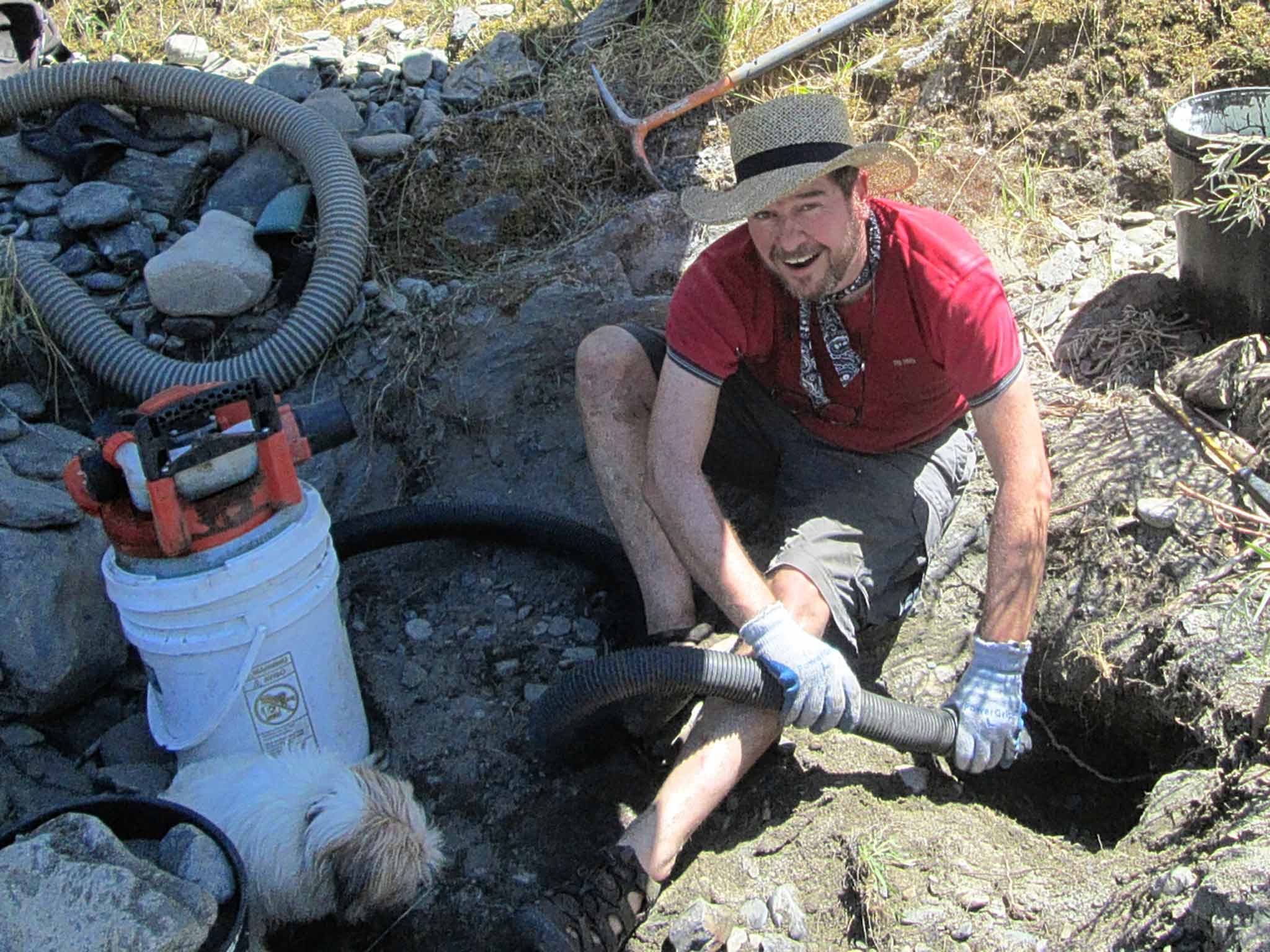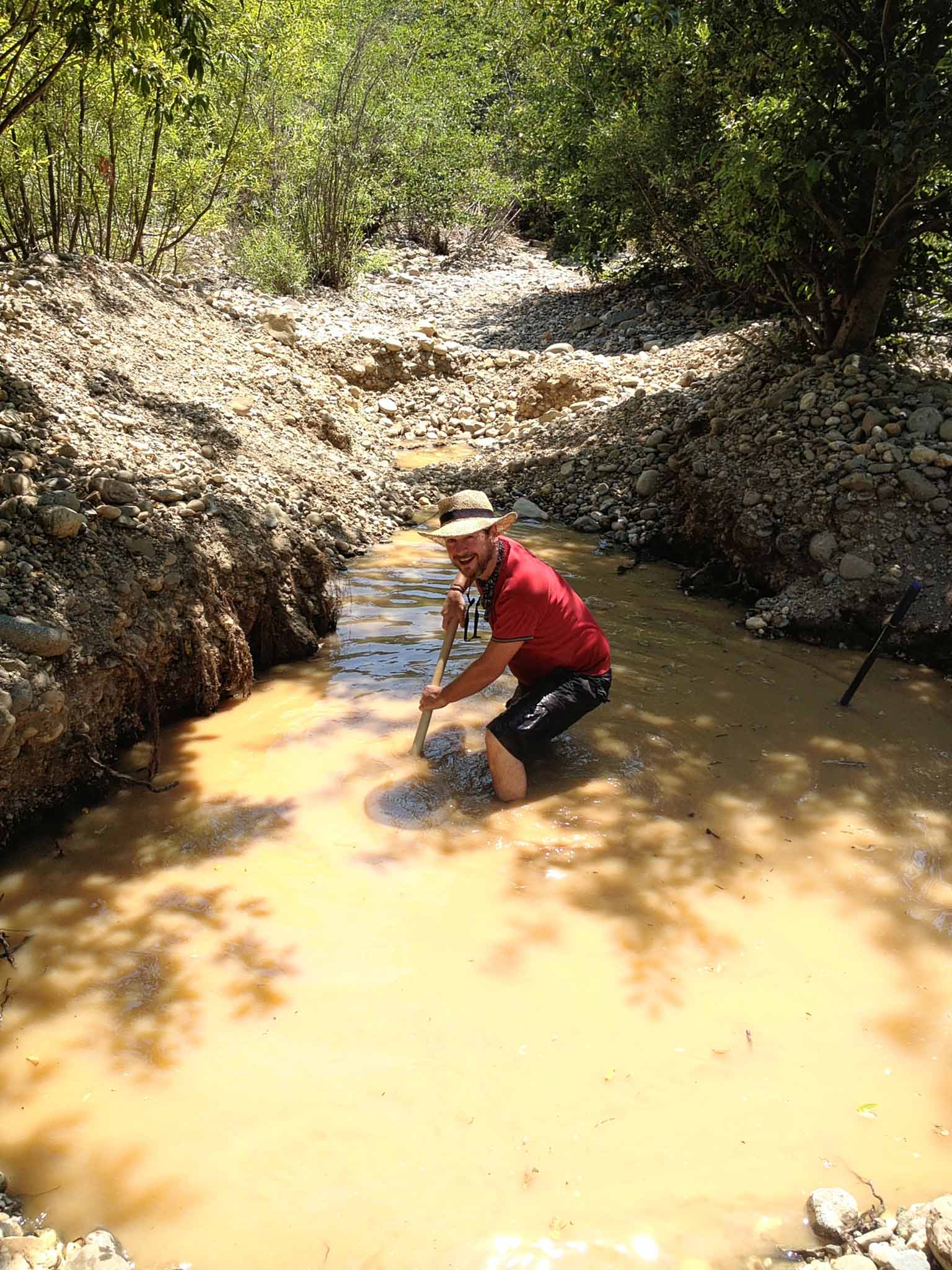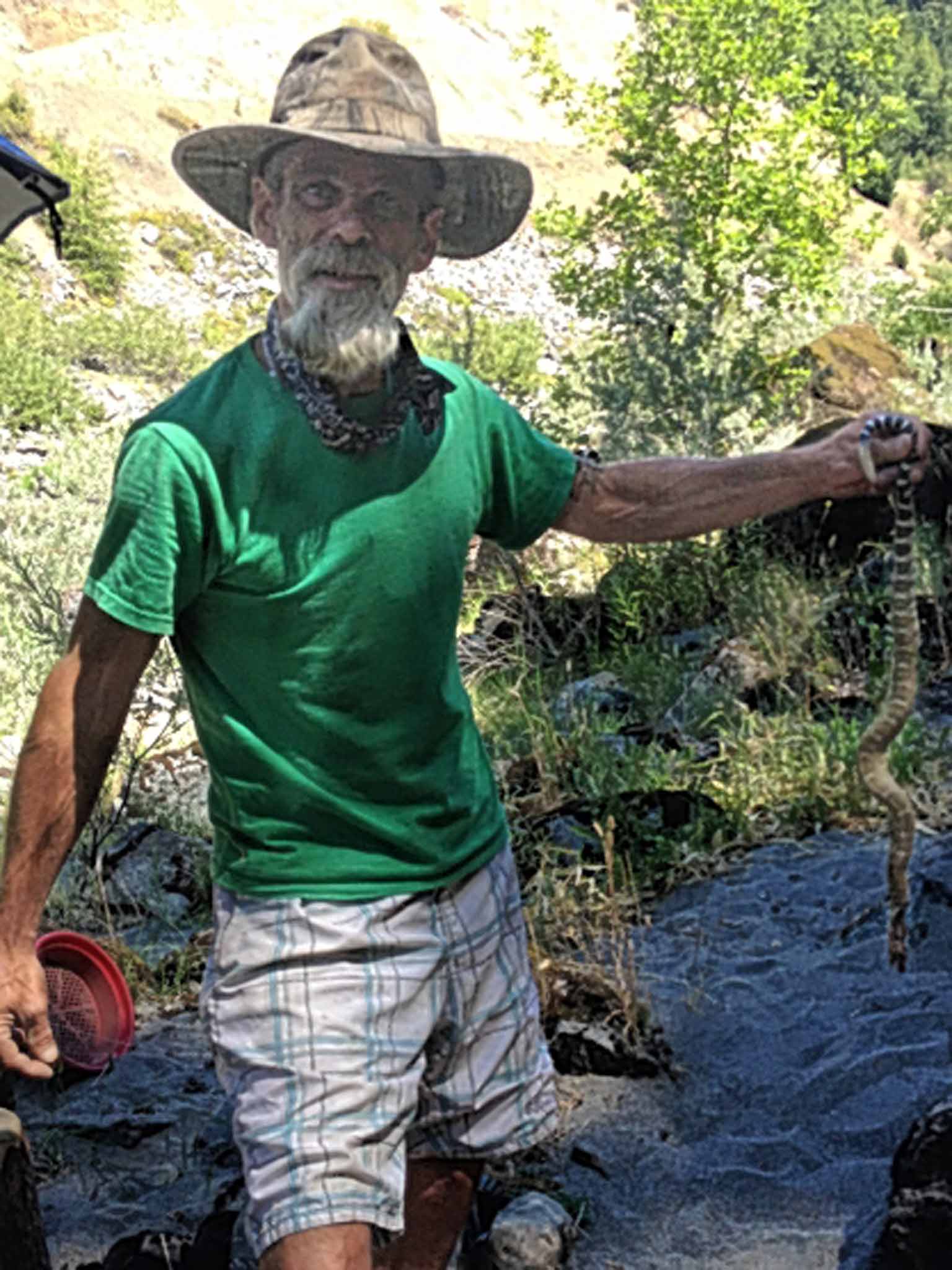How to find gold: The Californian badlands, digging out crevasses and sifting sludge
There's a first time for everything, and no time like now to remember it; so each week this summer, one of our writers will relate how they braved the shock of the new and found themselves changed for ever. To start the series, Steve Boggan goes in search of gold

Your support helps us to tell the story
From reproductive rights to climate change to Big Tech, The Independent is on the ground when the story is developing. Whether it's investigating the financials of Elon Musk's pro-Trump PAC or producing our latest documentary, 'The A Word', which shines a light on the American women fighting for reproductive rights, we know how important it is to parse out the facts from the messaging.
At such a critical moment in US history, we need reporters on the ground. Your donation allows us to keep sending journalists to speak to both sides of the story.
The Independent is trusted by Americans across the entire political spectrum. And unlike many other quality news outlets, we choose not to lock Americans out of our reporting and analysis with paywalls. We believe quality journalism should be available to everyone, paid for by those who can afford it.
Your support makes all the difference.I was looking into the eyes of a rattlesnake on the eastern bank of one of the United States' most remote rivers as the happy thought occurred to me that this was the least afraid of bears I had been all day.
For a moment, concerns over mountain lions, bubonic plague, tarantulas, dehydration, poison oak and ticks faded away as I became hypnotised by the snake's beautiful stare, a stare made all the more lovely by its being of the thousand-yard variety. That is, the snake was dead and its eyes shone from a decapitated head.
"Be good in slices, stir-fried with some onions and bell peppers," said Duane Wilburn, the man who had just separated head from body with his spade as, united, they had slithered up behind my tender, white, middle-aged bottom.
Duane, a 50-year-old former Marine, skinned the corpse cheerfully while I gazed into the clear waters of the Klamath River, trying to appear relaxed and wondering – not for the first time – how an idler like me, a tenderfoot with an aversion to hard work, came to be here, in the Siskiyou Wilderness, 10 million acres of pristine mountain and forest in north-western California, nursing blistered hands and panning for gold.
This was the summer of 2013. I didn't know it at the time, but I had contracted an illness and was deeply in denial of its possession of me: a 21st-century gold fever. Leaving behind my regular work, waving goodbye to my fiancée, travelling 5,000 miles to this most remote of places, camping out for the first time and barely controlling a constant, nagging terror of things that could maul, bite, eviscerate, sting, scratch or poison, seemed, at the time, perfectly normal.
I had never looked for gold before – it was my first time. But why on earth had I started?
For the answer, we must go back to Thursday, 13 March 2008. That was the day the price of gold went above $1,000 an ounce for the first time in history. All over the world, at least in countries with gold-bearing soil, people with no experience of prospecting noticed this and began shopping for shovels and pickaxes, gold pans, tents, generators and all manner of equipment they had no idea how to use.

Men and women whose judgement had previously gone unchallenged gave up jobs and left homes and families in the belief that they could strike it rich. In the US, they began to call this a new gold rush; the number of mining claim applications rose by 20 per cent in 12 months.
From a distance, I suspected this was nothing more than folly but I persuaded a magazine to send me to California to take a look for myself. What I found left me puzzled. The gold-seekers I met seemed broke, hungry and mostly bereft of the one thing they had come here for: gold. Yet cheerfully they kept on digging.
There was the couple mining for enough gold to cover the cost of their wedding; the man who had lost his job at the plant, living in a car and ignoring his wife's pleas to come home; and the pensioners who had exchanged their condos in Florida for motorhomes in the hills, pretending that – heck – it wasn't really about the gold, while digging for it to the point of exhaustion.
I met a few prospectors who had unearthed fistfuls of gold but they seemed as impoverished as those who had none. After a time, they would offer to show me their hoard and all would become clear; they couldn't bring themselves to sell it. They would rather starve. Why, I wondered, did they do this? Most admitted that they were unlikely to find the riches they had come for, but they kept on coming anyway.
I returned to London believing that there was something wrong with these people while feeling faintly envious of them. They woke each morning to fresh mountain air, to the sound of clean, clear water rushing over rocks, in the belief that today could be their day, the day they found a rich vein or a nugget the size of their fist.
And the odd thing is, they were right.
I began to study the California Gold Rush of 1849 and discovered that the frantic efforts of more than 300,000 miners – arguably the largest single migration event the world had ever seen – had made barely a dent in the state's reserves of gold; most geologists believe that 80 per cent of it has yet to be found. During the original rush, chunks weighing as much as 160lbs were uncovered – and remarkable pieces still turn up. Even last July a 5lb nugget found in California fetched $400,000 at auction.
In 1849, otherwise sensible people left their families, homes and professions, risking all on fantastic reports of a new El Dorado. It sounded terribly familiar. They travelled thousands of miles over hard country, desert and mountains to get to Gold Country. But many of them died – some estimates say one in five – either on their way to the goldfields or in the squalid conditions they found when they arrived there.
As I read of their adventures, I came to admire their courage and spirit. I found myself imagining where they had hunted for their gold and, increasingly, wanting to be there, wondering whether I, too, might discover some monstrous nugget, some life-changing hunk of metal.
Of course, I did nothing about this – it was a ridiculous notion, a wild fantasy.
The 2008 mini-rush came and went before another hove into view in 2011 as gold neared $2,000 an ounce. It had taken 6,000 years since the pharaohs first began mining gold for it to reach $1,000 an ounce, then just three more for that price to double. I found this utterly incredible. And that was when my curiosity became my malady. I promised myself that when the price of gold reached $2,000 an ounce, I would go and look for it.
By mid-2011, the Bank of America and Morgan Stanley were predicting that gold would crash through the $2,000 ceiling at some point in 2012. Secretly, my excitement was mounting but I was too embarrassed to tell anyone about it.
The price of gold climbed to $1,920 by September 2011 but then, aside from the occasional blip, it went down and down and down until by the end of June 2013 it was worth only $1,220 an ounce. The sense of loss I felt over gold's failure to reach the $2,000 mark surprised me. My excuse to go looking for it was gone and that mattered more to me than I had imagined.
My head told me that this was a good thing; it would have been a foolish enterprise and it would have ended in tears. But my heart told me something else; that I should go. Even if I found nothing it would be a great adventure.
That's when I realised that looking for gold is no more complicated than playing the Lottery. You know that the odds are stacked against you, but you buy a ticket anyway. Before I could change my mind, I packed a bag and, on 1 July 2013, boarded a flight to San Francisco, 300 miles south of where I would find myself standing next to that skinned rattlesnake.
During the previous two weeks, Duane had been one of a handful of gold prospectors to take me under their collective wing near the town of Happy Camp some 20 miles distant; a place given its wonderful name by a group of drunken miners who found gold there in 1851. When I had arrived, the greenest of greenhorns, Happy Camp's miners took pity on me and agreed to show me where and how to look for gold.
First, then, where?
Well, in California, all over the place. Gold has been found in the north, south and east of the state, primarily in the foothills of the Sierra Nevada mountains about two hours east of San Francisco. Later, during two months of prospecting, I would dig for gold there too, but for now I was up in the north, learning.
You might choose to dig tunnels into the ground, a process called "lode mining" (a lode is a subterranean vein of metal-bearing ore), or – the simpler method chosen by me – you could dig in or near rivers, what's called "placer mining" (pronounced "plasser") to try to find gold washed down from quartz veins running through mountain ranges.
This is released by erosion and carried downstream during ferocious floods and spring melts. When the water loses the kinetic energy it needs to carry the gold – as it hits rocks or slows on the inside bends of rivers – the metal will fall to the riverbed.
I asked one prospector, Terry McClure, a retired pipe-fitter from Seattle, Washington, to answer the "how?" of the matter.
"Well, there's lots of ways, but they all have one thing in common: hard work," he told me. "You gotta move earth or sand, gravel or rocks to get to gold, because it's always on the bottom. You gotta do it in cold and heat and you gotta put your back into it, either on land or under the water.
"Because gold is 19 times heavier than water and seven times heavier than anything else you're likely to find in the river, you'll always reach it at bedrock. It's gravity, pure and simple."
Of course, they taught me how to use a gold pan, and gravity plays its part here, too. You put a trowel full of the dirt you find at bedrock into the pan and shake it vigorously, which, of course, teases the heaviest concentrates to the bottom. You wash it away layer by layer until all that remains is heavy iron-rich black sand and, if you're lucky, gold.
I found my first gold the day after being introduced to Duane. I had bought a pan, a pick-axe, a shovel, some buckets, a classifier sieve for grading down soil, and a glass bottle for the gold I would find, and headed off, all bright and shiny to a spot called Wingate Bar on the Klamath, about 10 miles outside Happy Camp.
This was it, I thought, I'm prospecting for gold! I had rarely felt sillier and found myself looking over my shoulder for bears or miners who might see me waddling, green as cabbage.
After a few minutes' walking, the trail opened into a clearing above the river and the silence was shattered by the sound of a loud engine. Below me was a miner in a very large hole using a vacuum hose to suck up all the loose dirt – and gold – from the crevices he was uncovering.
"HELLO!" I yelled.
The miner shot up and turned around, switching off his engine. I advanced with my hand out and he told me his name was Doug McDowall, a retired electrical utility worker from Rainier in Oregon.
"That's appropriate," I said.
"What?"
"Doug."
"What?"
"Nothing."
I could see the miner looking at all my new equipment.
"It's my first time," I said. Doug raised his eyebrows. "This moment is literally the first time I have ever tried to find gold. Right here, right now." His eyes flitted to my bucket. "Never been used. Look; my pick. It's shiny."

"Sure is," he said. "You know what you're looking for?" And without waiting for a reply, Doug told me why this was a promising location – because there had been a notorious flood here in 1996 and there was evidence of its terrifying presence at a spot where rocks and a bend in the river would have slowed it down. He told me to search crevices and folds in bedrock and to empty them with purpose because I could be sure that weather, water and gravity would have dragged the gold deposits down there.
I thanked him and wandered down the river, making enough noise to frighten off bears and rattlers, until I found a likely spot. There were rocks that seemed out of place high above the waterline, deep granite creases that were filled with sand and pebbles that had travelled far from the normal course of the river. I decided to clear out the rocks and dirt from a crevice about 2ft wide where I imagined water crashing, slowing down and losing the gold that had been in thrall to it.
The river was only 30ft or so across at this point and on the other side was a flat clearing with thin growths of willow and young white fir. To the south, the Marble Mountains, draped in spruce and ponderosa, reared up to the sky. It was 110°F but I began digging furiously, a breeze from the Klamath's icy waters cooling me down. I reached bedrock some 3ft below and began filling my bucket with "pay dirt" graded through its classifier – then I ran to the water's edge, waded in with bare feet and sat on a rock, gold pan in hand.
I put a trowel-full of pay dirt from my bucket into the pan and submerged the whole thing into the water between my ankles, shaking it vigorously so any gold would find its way to the bottom. Then, remembering how I had seen other miners do this, I carefully washed away the surface layers, shaking and twisting the pan regularly so that the heavier deposits would be teased downwards. My excitement was reaching a peak; I would soon see gold.
Eventually, all that was left was black sand and I told myself that precious flakes and nuggets would emerge any second as I gently washed it away. But there was nothing. I washed everything in the bucket but found no gold. It was the same with the second bucket.
Then, in the last pan from my third bucket of dirt, my hole in the ground now waist-deep, sweat coursing down my brow, my hands and knees raw, I was suddenly dazzled by the appearance of a small flake as it emerged from the sand in my pan. There was just one sliver, about the size of half a grain of short-grain rice but it was unmistakeable and in that moment I imagined it lit up my face.
It was gold, and it was all mine.
Steve Boggan is author of 'Gold Fever: One Man's Adventures on the Trail of the Gold Rush' (Oneworld Publications, £14.99)
Join our commenting forum
Join thought-provoking conversations, follow other Independent readers and see their replies
Comments